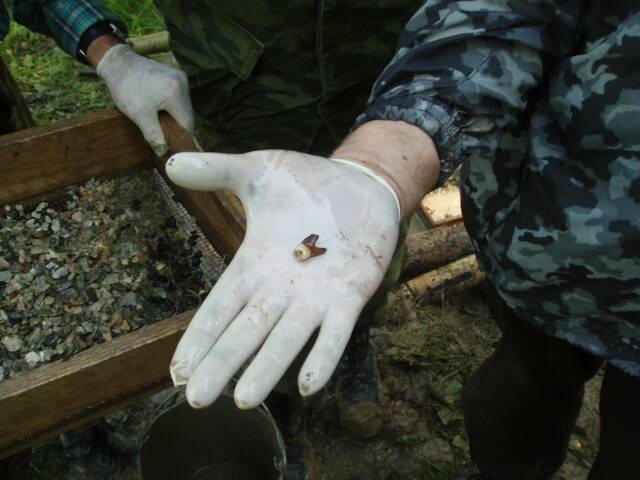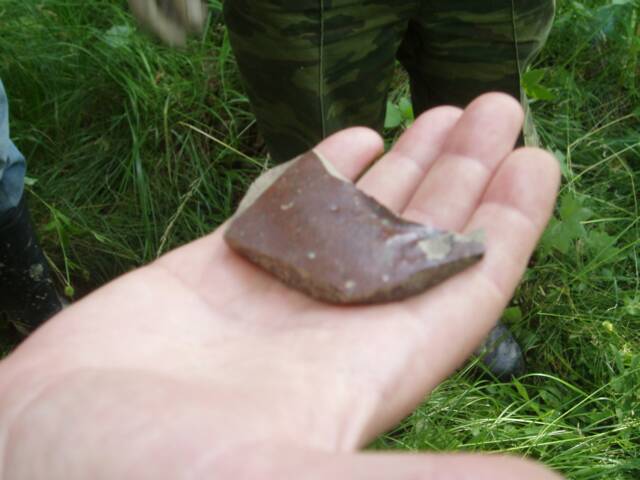In early August 2007, Dr. Sergey Nikitin informed Capt.Peter Sarandinaki, Director of the SEARCH Foundation, that members of an Ekaterinburg based military historical club called "Mountain Shield", may have found the missing remains of the Romanov children, the Tsarevich Alexis and his sister, Grand Duchess Maria in the Southern part of the Pig's Meadow.
The initial Russian Press Realease stated the following:
1. In June 2007, at the initiative of A.E. Grigoriev, Deputy Director of the Regional Center for the Preservation of Monuments in the Sverdlovsk Region, V.V. Shitov, a historian and local lore expert and N.B. Neujmin, a member of the military historical club “Mountain Shield”, understanding what an impact this event would have on world history, a decision was made to undertake new searches along the Old Koptyaki Road with the goal of discovering a supposed second area where the remains of members of the Romanov Imperial family were concealed.
2. In order to do this, preliminary consultations took place with the Sverdlovsk Region’s Ministry of Culture; the Institute of History & Archeology – Russian Academy of Sciences, Ural Division; Museum to the Memory of the Romanovs and “Obreteniye” Foundation – that first searched these areas; and the Institute of Flora and Fauna Ecology at the Russian Academy of Sciences, Ural Division.
Dr. A. Avdonin's map showing areas previously searched
1. Burial site of the the Romanovs and faithfulservants found in 1978
2. Burial site where Tsarevich Alexis and his sister Grand Duchess Maria found in 2007
3.The Center for Scientific Research & Development, with the financial support of S.M. Khudyakov, Director of “Trak”, an LLC (having an agreement for the supervision of any archeological works) came forth as the organizer and leader of the planned works.
4.The first stage of the search used a series of reconnaissance methods in areas not previously searched. If there were no results from that, a second method of laying archeological trenches was intended. In order to scout out the areas, members of the military historical club, “Mountain Shield” were invited, under the leadership of A.M. Kruchinin.
5.On July 29, 2007, certain items were discovered by S.O. Plotnikov and L.G. Vakhmyakov. In the bore pit that had been located and explored, coals, bone remains, nails and fragments from a ceramic vessel were unearthed.
6.On July 30, 2007 the decision was made to reorganize the expedition to include the efforts of the Center for Scientific Research & Development -- Department Head, S.N. Pogorelov; Institute of History & Archeology, Russian Academy of Sciences – Ural Division -- Deputy, Candidate of Historical Sciences, E. A. Kurlaev and Anthropologist, Candidate of Historical Sciences, D. P. Razhev; Institute of Flora & Fauna Ecology, Russian Academy of Sciences – Ural Division – Biologist, N.G. Yerokhin; Consultant, Doctor of Geological Sciences, A.N. Avdonin; as well as others working with the Scientific Research & Development Center, Ural state institutions and members of the “Mountain Shield” club and “Obreteniye Foundation”.
7.At this stage of the study, an area of 100 square meters was laid out for further investigation. The work was carried out according to archeological methods, with the use of drainage trenches. As a result of this exploration, a large spot of coal was exposed. Upon further examination, this spot was determined to be T-shaped. After removing the layer of coal, the shapes and sizes of two overlying pits became evident in the subsoil.
8. The pits had quasi-oval shapes, were step-patterned and perpendicular to one another. The northern pit, measuring 1.5 x .5 meters, with a coal fill of up to .35 meters contained calcined (burned) bone remains, nails and small fragments of ceramic. The southern pit, measuring approximately 1.2 x .9 meters with a coal fill of .60 meters contained fresh (unburned) and calcined (burned) bone remains, nails, iron angles, large fragments of a ceramic vessel and bullets. In the process of sifting and washing through the soil, tiny fragments of artifacts were found.
9.The collected materials were sent to a research lab for work up, taking into account safekeeping and a limited access to these items.
10.Work has already begun on various scientific analyses (archival, archeological, anthropological and biological) – thus forming a complete scientific account.
11.Bone remains and bullets were transferred to the regional forensic labs for testing. This transfer was done according to a certified decree by the Senior Criminal Procurator of the Russian Federation’s Senior Justice Advisor, V.N. Soloviev. Notification of this find has been sent to the governor of the Sverdlovsk Region, E.E. Rossel and His Holiness, Patriarch Alexey.
12.Based on initial investigations, one can make the following preliminary conclusions and establish facts:
- An area discovered along the Old Koptyaki Road presented double bonfire sites, spread between pits, which contained bone remains in various degrees of preservation and condition; bullets; iron nails and angles, fragments of a ceramic vessel and other objects.
- Initial anthropological analysis determined that the bone remains were human, subjected to varying forms of destruction – including burning. The bones belong to two young individuals – a young man between the ages of 10-13 years, and a young woman about 18-23.
- Ceramic vessel fragments are identical to those found in the original burial site found in 1991, and appear to be fragments from ceramic amphorae containing Japanese sulfuric acid.
- Iron angles and nails, apparently, appear to have held together the wooden crates containing the vessels with the sulfuric acid.
- The metal jacket bullets are of different calibers, from cartridges for short-barreled firearms.
- This set of facts, the location, area, bone remains, bullets, ceramics, iron fasteners, as well as the result from the anthropological analysis, allows one to come to the conclusion that the place and remains of members of the Romanov Imperial Family, Tsarevich Alexei and his sister, Grand Dutchess Maria, concealed by revolutionaries in 1918, has been found.
A.E. Grigoriev, Deputy General Director of the Scientific Research & Dev. Center
S.N. Pogorelov, Deputy Head of Archeological Research Dept., Scientific Research & Dev. Center
E.A. Kurlaev, Doctor, Institute of History & Archeology, Russian Academy of Sciences – Ural Region
D.I. Razhev, Senior Scientist at the Institute of History & Archeology, Russian Academy of Sciences – Ural Region
N.G. Yerokhin, Scientist at the Institute of Flora & Fauna Ecology, Russian Academy of Sciences – Ural Region





